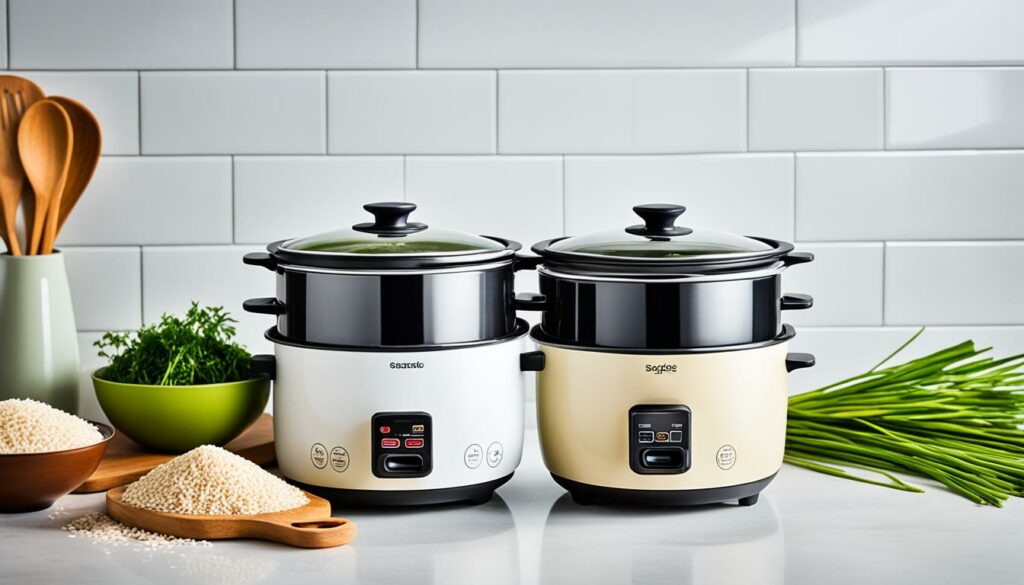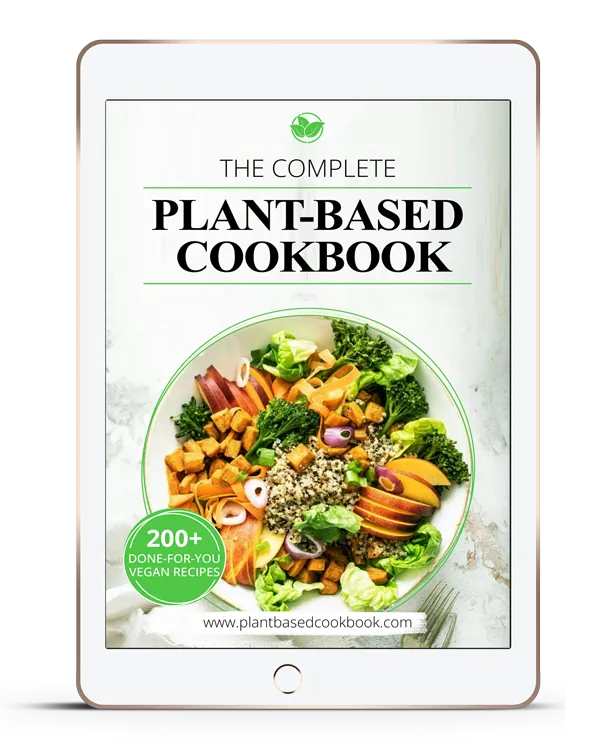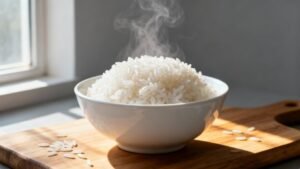“The kitchen is where we deal with the elements of the universe and play with them in novel ways.” – Homaro Cantu
I think having the right kitchen tools is crucial for great cooking. One tough decision is choosing between ceramic and non-stick rice cookers. Each type offers unique benefits that affect how your meals turn out.
In my search for the best rice cooker, I’ve tried many types. Ceramic rice cookers provide even cooking and don’t use harmful chemicals. Non-stick models, on the other hand, are easy to clean and cost less. But, which type is better for your kitchen?
Let’s explore the difference between ceramic and non-stick rice cookers. We’ll look at what each offers and help you choose wisely for your cooking. Are you ready to learn the secrets to making perfect rice? Let’s start!
Table of Contents
ToggleIntroduction to Rice Cooker Materials
Shopping for a rice cooker means I think about how it will affect my cooking. The materials a rice cooker is made of matter a lot. They affect cooking performance and the healthiness of the food we make.
The Importance of Choosing the Right Rice Cooker
Finding the right rice cooker isn’t just about its appearance. The materials it’s made from change how well it cooks, its energy use, and health effects. For example, the type of material can make my rice cook differently and affect my electricity bills.
Overview of Ceramic and Non-Stick Options
When it comes to rice cookers, we often think about ceramic and non-stick pots. Ceramic cookers spread heat evenly, helping to keep food tasty. Non-stick cookers, on the other hand, are easy to clean and friendlier to our budget.
Impact on Cooking Performance and Health
The material of a rice cooker does more than impact rice. Ceramic is best for healthy cooking because it doesn’t release harmful substances. While non-stick is convenient for cleaning, it can be risky if not used right. Both can be good for saving electricity, but the best choice depends on our usual cooking and health concerns.
| Material | Cooking Performance | Health Impact | Energy Efficiency |
|---|---|---|---|
| Ceramic | Even heat distribution | No chemical leaching | Good heat retention |
| Non-Stick | Quick cooking | Potential concerns with high heat | Fast heating, less energy use |
Ceramic Rice Cookers: A Closer Look
Ceramic cookware has always caught my eye. In the world of rice cookers, ceramic brings together old ways and new tech. So what makes ceramic rice cookers special? We’ll look into that, including their benefits, downsides, and how to take care of them.
Advantages of Ceramic Cooking Pots
Ceramic rice cookers have their perks. They cook rice evenly, making sure it’s just right every time. These pots are tough and can handle high heat. Their smooth surface helps keep rice tasting as it should and doesn’t let any harmful chemicals into your meal.
Potential Drawbacks of Ceramic Rice Cookers
Not everything about ceramic cookers is perfect, though. They’re heavier. Some might find this a drawback. Also, ceramic pots can chip or crack if they’re not treated gently. Their ability to hold heat well may sometimes overcook your rice if you’re not watching the clock.
Maintenance Tips for Ceramic Rice Cookers
To keep your ceramic rice cooker shining, remember these tips:
- Clean with a soft sponge and mild detergent
- Avoid sudden temperature changes to prevent cracking
- Use wooden or silicone utensils to prevent scratching
- Allow the pot to cool before cleaning
With the right care, your ceramic rice cooker can stay with you for a long time. It will add not just function but also a classy look to your kitchen.
Non-Stick Rice Cookers: Understanding the Technology
I’ve found that non-stick rice cookers are popular for good reasons. These appliances typically use Teflon or other non-stick coatings. They are on aluminum or stainless steel pots. The technology behind these cookers offers great benefits for home cooks.
Non-stick rice cookers stop rice from sticking to the pot. This makes cleanup easy and ensures perfect rice every time. They heat up quickly, which means faster meal prep. Non-stick rice cookers are also cheaper than ceramic ones, so more people can afford them.
However, non-stick coatings may not last forever. They could wear off. Using non-metal utensils and avoiding high heat can help your cooker last longer. Some folks are also worried about health risks if Teflon gets too hot.
When picking a rice cooker, think about these points. Non-stick cookers are convenient and budget-friendly. But, ceramic ones might be better for those who want something that lasts and is safer.
Ceramic vs. Non-Stick Rice Cookers: A Comprehensive Comparison
Choosing between ceramic and non-stick rice cookers involves many important aspects. I’ve done a comparison for you. This will help you choose wisely for your kitchen.
Cooking Performance and Heat Distribution
Ceramic rice cookers spread heat well and keep it steady. This makes rice cook evenly. Non-stick cookers, on the other hand, heat up fast but might not make rice as evenly.
Durability and Longevity
Ceramic pots last a long time with good care, thanks to their tough build. They resist scratches and stay non-stick for years. But, non-stick coatings can wear out with lots of use, needing a replacement.
Health and Safety Considerations
Ceramic cookers are free of the worries that come with some non-stick coatings. They’re a healthy choice. Non-stick cookers are generally safe but might worry some people about chemicals if they get too hot.
Ease of Cleaning and Maintenance
Both types are good for cleaning, but non-stick is easier. Ceramic pots can stick a bit, which means you need to clean carefully. But, because ceramics are tough, you can clean them more intensely.
| Feature | Ceramic Rice Cookers | Non-Stick Rice Cookers |
|---|---|---|
| Heat Distribution | Excellent | Good |
| Durability | High | Medium |
| Health Safety | Very High | High |
| Easy Cleaning | Good | Excellent |
Flavor Preservation and Food Quality
I’m always intrigued by how cooking gear affects the taste of our food. The material in a rice cooker’s pot is key. It helps keep the flavor and nutrients in your meals.
Ceramic rice cookers are top-notch for sealing in flavor. The ceramic doesn’t mess with how your food tastes. This is great for making special meals or trying new types of rice.
But, a non-stick rice cooker might add a light taste or smell at first. This issue fades as you use it more. Despite this, they cook rice well and keep quality high.
| Feature | Ceramic Rice Cooker | Non-Stick Rice Cooker |
|---|---|---|
| Flavor Preservation | Excellent | Good |
| Initial Odor | None | Slight (fades over time) |
| Versatility | High (suitable for various dishes) | Moderate |
| Heat Distribution | Even | Even |
I’ve found that both ceramic and non-stick rice cookers can work great. The secret is to know what each one is good at. Then, pick the best fit for how you like to cook.
Environmental Impact and Sustainability
In the choice between ceramic and non-stick rice cookers, their impact on the Earth matters. Both have different effects, starting from their making to being thrown away.
Manufacturing Processes
Ceramic cookware makes are kinder to the environment. They use natural stuff and less energy. In contrast, the making of non-stick pans uses chemicals bad for the environment.
Recyclability and Disposal
When it comes to recyclability and disposal, ceramic is a winner. It can be recycled easily and breaks down naturally. Yet, non-stick pans can’t be recycled as they are, making ceramic a green choice.

Long-Term Environmental Considerations
For me, the lasting power of my kitchen tools is crucial. Ceramic rice cookers last longer, meaning fewer replacements are needed. This sustains energy-efficient cooking over the years. Whereas, non-stick pans need changing more, adding to waste.
| Aspect | Ceramic | Non-Stick |
|---|---|---|
| Production Impact | Lower | Higher |
| Recyclability | High | Low |
| Lifespan | Longer | Shorter |
| Energy Efficiency | Good | Variable |
In my search for sustainable kitchenware, ceramic rice cookers stand out. They are better for the environment from start to finish. Plus, they match my aim for energy-saving cooking.
Price Comparison and Value for Money
When I shop for kitchen appliances, I look at the price and what I’m getting. Today, let’s talk about rice cookers. We’ll see how ceramic and non-stick rice cookers stack up. This comparison will help you choose one that’s both budget-friendly and meets your needs.
Non-stick rice cookers are a good pick if you’re watching your wallet. They’re easy to find and fit different budgets. Their affordability makes them a top choice for many.
On the flip side, ceramic rice cookers usually cost a bit more. But, they’re built to last and are great for various dishes. They might cost extra at first, but they offer long-term benefits.
| Feature | Non-Stick | Ceramic |
|---|---|---|
| Initial Cost | Lower | Higher |
| Lifespan | 3-5 years | 5-10 years |
| Versatility | Limited | High |
Choosing the right rice cooker depends on your needs for the future. If saving money or occasional rice cooking is your goal, go with non-stick. But, if you want a cooker that does more and lasts longer, consider ceramic.
Keep in mind, the best deal is more than just the price. Think about how durable it is, its cooking abilities, and how often you’ll use it. This way, you’ll pick a rice cooker that’s truly worth your money.
Conclusion
I’ve looked into both ceramic and non-stick rice cookers. Each type fits well in today’s kitchens. Ceramic cookers are known for spreading heat well and keeping flavors vibrant. This makes them ideal for those valuing taste and health in their cooking gear.
Non-stick rice cookers make cooking simple and affordable. They are a boon for people leading busy lives. When trying to choose, think about your cooking style, health needs, and how much upkeep you’re willing to do.
Ultimately, both ceramic and non-stick versions can whip up great rice dishes. The decision rests on what you care about most in the kitchen. Choosing between the timeless appeal of ceramic or the straightforwardness of non-stick is up to you. Either way, you’re investing in a great tool for your kitchen.
FAQ
What are the main differences between ceramic and non-stick rice cookers?
Ceramic rice cookers have pots made of ceramic. They cook food evenly and keep its flavor. Plus, they don’t react with what you’re cooking. Non-stick cookers have Teflon coating on their pots. This coating makes food not stick and heats up fast.
Which type of rice cooker is better for health considerations?
Ceramic cookers might be better for your health. They don’t have the chemicals that some non-stick pots do. Ceramic is safe and won’t let bad stuff into your food.
How do ceramic and non-stick rice cookers compare in terms of ease of cleaning?
Both are easy to clean. But, non-stick pots need less work to keep them looking good. You can use a soft sponge and light soap on ceramic. Non-stick pots are quick to clean.
Which type of rice cooker is more durable and long-lasting?
Ceramic cookers last a long time. They don’t peel like non-stick pots can. Still, ceramic pots can break if you’re not careful with them.
How do ceramic and non-stick rice cookers compare in terms of environmental impact?
The making of ceramic cookware is better for the Earth. It’s easier to recycle and it breaks down naturally. Non-stick pots, however, have issues with making and throwing away PTFE.
Which type of rice cooker is better for preserving the natural flavors of food?
Ceramic cookers are great at keeping food’s natural tastes. They don’t change the flavor. This makes them good for many kinds of dishes.






